How to check the differential machine and RCD
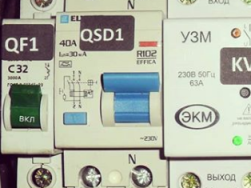 Residual current circuit breakers residual current circuit breakers are designed to disconnect power when a leakage current occurs. This is often called differential protection. However, any switching device must be checked, both for operation as such, and for compliance with the nominal parameters.
Residual current circuit breakers residual current circuit breakers are designed to disconnect power when a leakage current occurs. This is often called differential protection. However, any switching device must be checked, both for operation as such, and for compliance with the nominal parameters.
Does the residual current device, as they are called "RCD", be triggered when the current difference between the poles is different. In simple terms, the principle of operation of these devices is to compare the current through phase and zero. If the current through the phase is greater than zero, it means that part of it flowed in a different way, for example, insulation of the conductors was damaged or the heating element broke and a current of a certain magnitude "flows" to the ground. If the body of the appliance is grounded - this situation is not too terrible and even with good grounding is not even dangerous, but if you have a two-wire power supply network without grounding,then on hit potential ...
Why is the neutral wire heated
 Heating the neutral wire can cause it to burn out and cause a power accident. Most often this happens when the loads are unevenly distributed across the phases in a three-phase power supply and due to poor contact. In this article we will explain why the neutral wire is heated and what to do in this situation. In order for the reasons for heating zero, you need to understand how a three-phase network works.
Heating the neutral wire can cause it to burn out and cause a power accident. Most often this happens when the loads are unevenly distributed across the phases in a three-phase power supply and due to poor contact. In this article we will explain why the neutral wire is heated and what to do in this situation. In order for the reasons for heating zero, you need to understand how a three-phase network works.
The load in the three-phase network can be connected by a star and a triangle, and the windings of the supply transformer can also be connected. The winding has two conclusions - the end and the beginning. If the ends of the windings of a three-phase transformer are connected at one point - then they say that this is a star connection diagram. According to Kirchhoff’s laws, at the point of their connection (O), the current will always be zero, that is, flow from phase to phase. If the load in each of the phases is the same, then the voltage at the beginning of the windings will be equal ...
How to find out how much power a cable or wire can withstand
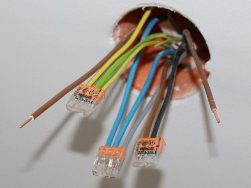 When connecting electrical appliances to the supply network, one of the main conditions is the selection of a cable or wire of suitable section. But sometimes it happens that you already have some kind of conductor, and you are not sure whether it is suitable for a specific task.
When connecting electrical appliances to the supply network, one of the main conditions is the selection of a cable or wire of suitable section. But sometimes it happens that you already have some kind of conductor, and you are not sure whether it is suitable for a specific task.
If you connect too much load on the cable, then it will warm up, and maybe even overheat. Because of this, the insulation will melt, which is dangerous with a short circuit, electric shock and fire. This begs the question: "how do you know how much power a cable or wire can withstand?". Let's figure it out! It is immediately worth noting that the cross-section and power of the cable are, in principle, not interconnected. For the conductor, the permissible continuous current plays a decisive role. These values are described in the PUE section 1, chapter 1.3. The fact is that if it can withstand a current of 16A, then in a 220V network it is 3.5 kW, for 380V it is 10 kW, and in a 12V network it is only 192W. Therefore, it is reasonable to talk about the permissible power for the cable ...
Current clamp application examples
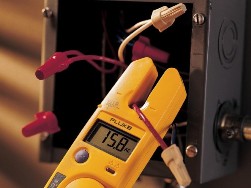 To diagnose malfunctions in electrical equipment or electrical installations, it is often necessary to measure currents. There are two options: use an ammeter or using current clamps. The first option can be done using a conventional multimeter, but it is bad in that you need to break the circuit, and this is not always possible and not always convenient for correct measurements. The second method, clamp meters, allows you to find out the current in the circuit without disconnecting it.
To diagnose malfunctions in electrical equipment or electrical installations, it is often necessary to measure currents. There are two options: use an ammeter or using current clamps. The first option can be done using a conventional multimeter, but it is bad in that you need to break the circuit, and this is not always possible and not always convenient for correct measurements. The second method, clamp meters, allows you to find out the current in the circuit without disconnecting it.
The principle of operation of current clamps is based on the phenomenon of electromagnetic induction. The conductor, in which the current is measured, is inserted into the magnet wire, on which the secondary winding is wound. The measured current in this case is called primary, and the current in the measuring coil (secondary winding) is called secondary.Moreover, its value is proportional to the primary current and can be calculated. Previously, clamp meters, for the most part, could only measure alternating current ...
How to repair a wire, cable or cord
 Most of the equipment that runs on electricity is powered by wires. But their veins and insulation are not eternal, so the wires are thrown or torn, or their insulation is frayed. In this article, we will consider the main malfunctions and methods of repairing wires, cables and cords.
Most of the equipment that runs on electricity is powered by wires. But their veins and insulation are not eternal, so the wires are thrown or torn, or their insulation is frayed. In this article, we will consider the main malfunctions and methods of repairing wires, cables and cords.
In the everyday sense, wires, cables and cords do not have significant design differences. The insulation or flexibility class of the core may be modified, but in both senses there is not much difference. It is worth noting that, when it comes to mobile equipment, for example: iron, electric drill, grinder, charging for the phone - their conductors are called cords. If we are talking about wiring internal or external - these conductors are called cables (not always, depending on the product used), but if we are talking about connections inside the devices or extension cords - these are most often wires.All cable products consist of ...
How to build wires in a socket
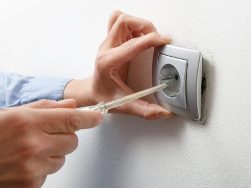 Replacing the outlet is simple, but not always everything goes as you want. It often happens that you can’t just take and plug in a new outlet, because the length of the old wires is not enough. They can break off or simply the design of the new outlet is different and it is not possible to clamp the wires normally. In this article, we will look at ways to lengthen short wires.
Replacing the outlet is simple, but not always everything goes as you want. It often happens that you can’t just take and plug in a new outlet, because the length of the old wires is not enough. They can break off or simply the design of the new outlet is different and it is not possible to clamp the wires normally. In this article, we will look at ways to lengthen short wires.
Wires and cables can have single-wire cores - these are cores that consist of a single solid wire, they are called rigid or monolithic cores. Frequent bending may break. Another type - multi-wire veins - they are soft, consist of several thin wires. It is often called stranded or flexible to bend such wires. The number of wires depends on the flexibility class of the core - the higher it is, the more wires. How does this relate to the extension of wires in the outlet? The fact is that the method of connecting them depends on the type of cores ...
Marking of circuit breakers: meaning and interpretation
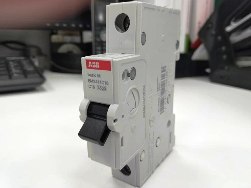 Everyone knows the circuit breakers. In the people they are called simply "automatic". And everyone in the house or apartment has at least one, or even two such devices. Automatic machines protect wiring from emergency situations and prevent their development. Manufacturers print a whole series of text on their case, but not everyone understands what it says. This article will help you decipher the label of circuit breakers.
Everyone knows the circuit breakers. In the people they are called simply "automatic". And everyone in the house or apartment has at least one, or even two such devices. Automatic machines protect wiring from emergency situations and prevent their development. Manufacturers print a whole series of text on their case, but not everyone understands what it says. This article will help you decipher the label of circuit breakers.
In terms of the appearance of the majority, it is impossible to determine what current it is rated for, the only thing you can guess from its size is it passes a large or small current and how many phases (poles) it is designed for. How to determine the characteristics of the machine? You just need to read the markings.Marking a series of machines allows you to find complete documentation with all the technical characteristics and features of the model. It is indicated either under the logo of the manufacturer ...
How to distinguish electronic RCD and electromechanical: features of the device and application
 RCD - a residual current device or differential current switch is installed to protect a person from electric shock. However, not everyone knows that there are two types of RCDs: electronic and electromechanical. In this article we will talk about what are the differences between RCDs of different types and how to determine the type when buying.
RCD - a residual current device or differential current switch is installed to protect a person from electric shock. However, not everyone knows that there are two types of RCDs: electronic and electromechanical. In this article we will talk about what are the differences between RCDs of different types and how to determine the type when buying.
In general terms, the principle of operation of the RCD is as follows: when the current through the phase wire differs from the current through the neutral wire, a relay is activated that disconnects the load. The current is detected using a differential transformer and a polarized relay.A situation where currents of different sizes flow through a phase and neutral wire can occur if a device has a leak on the housing. A leak to the housing occurs if the insulation of one of the conductors of the electrical appliance is damaged and touches the housing ...
